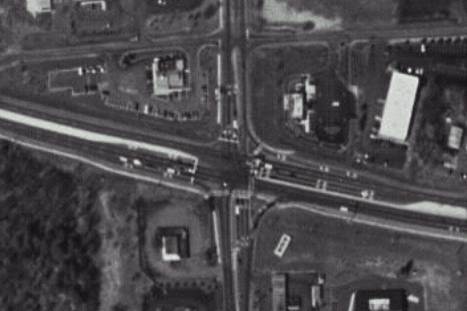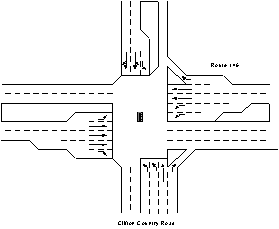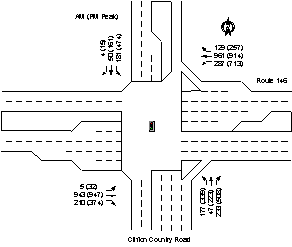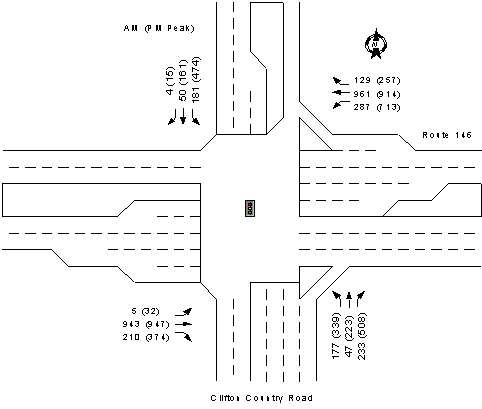
Problem 4: Clifton Country Road The intersection of Clifton Country Road and Route 146 (Intersection D) is the most complex, busiest, largest, and most complex in the network. Exhibit 2-36 shows an aerial photograph of the site. (North is toward the top.) The main question at this intersection will be: are geometric changes and/or adjustments in signal timing needed to accommodate the site-generated traffic? Since a lot of the site-generated traffic will be going to and from I-87, the signal timings will have to change, dictated by the actuated controller. But geometric changes might be needed as well. In the process of answering these questions, we can use this intersection to illustrate a number of analysis issues. As you can see in Exhibit 2-37, the intersection’s eastbound approach is five lanes wide (left, triple through, and signalized right). The westbound approach is also five lanes wide (double left, double through, and free right). The southbound approach has three lanes (left, left/through, and right/through) while the northbound approach has four (double left, through, and free right). The eastbound left-turn bay is about 150 feet long. The westbound left-turn bay is about 400 feet long so it can accommodate heavy volumes coming from I-87. On the southbound approach, there’s space to store about 10 cars per lane to the upstream intersection with Old Route 146. On the northbound approach, about 20 cars can be stored per lane prior to the first side road intersection. |
Page Break
Problem 4: Clifton Country Road As you can tell from the overview of the network we presented in the introduction, there are large shopping plazas both north and south of the intersection. The road to the north ends in a shopping center parking lot while the one to the south threads its way between the Clifton Park Center shopping mall on the east and the Shopper’s World shopping center on the west. About a tenth of a mile east of the intersection is the freeway interchange with I-87. That location will be the focal point of Problem 5. To the west is the Maxell Drive intersection that was the focal point of Problem 1. Base Case Phasing and Volumes Analysis Plans Description of Analyses Sub-problem 4a: AM peak hour - Existing Conditions
Sub-problem 4b: Sub-problem 4c: 2004 PM - With vs Without Conditions Discussion: |
Page Break
Problem 4: Clifton Country Road Base Case Phasing and Volumes The signal control is fully-actuated. Exhibit 2-38 shows the phasing. Phases 1-3 are for the east-west flows. The first phase is often skipped because the eastbound left turning volumes are small. Phases 4-5 are for the north-south movements except that Phase 4 has a protected green for the eastbound right.
The intersecting volumes are generally high. Exhibit 2-39 shows the AM and PM peak hour flows for the base case. No standing queues exist at the end of the peak hour. The largest volumes are on the eastbound and westbound approaches. The westbound through volume is generally the largest, as I-87 generates a lot of traffic. The eastbound through is also quite large due to traffic going toward I-87. The volumes on the north and southbound approaches are relatively small in the AM peak hour and much larger in the PM peak hour. This is because of the shopping center-related traffic. |
||||
|
to Analysis Plans |
Page Break
|
Exhibit 2-39. Clifton Country Road Intersection Volumes for Existing AM & PM Peak Hours
|
Page Break
Problem 4: Clifton Country Road
Analysis
Plans to Overarching Issues |
Page Break
Problem 4: Clifton Country Road
Overarching
Issues The first relates to how many time periods we should analyze. That is, what time periods should be considered in examining the intersection’s performance? The answer is several. Clearly, the AM and PM peak hours should be examined. The intersection is part of a major east-west arterial, next to a major freeway interchange. However, the Saturday shopping peak should be examined as well. The intersection is adjacent to three major shopping centers. We also need to think about whether there’s a peak hour of the generator that’s different from all three time periods, or a peak traffic condition that relates to this specific intersection. For example, we might want to examine the conditions on a Friday afternoon peak hour when the shopping volumes are heavier than they are during the rest of the week. Moreover, we might want to do a separate analysis of the intersection for the Friday afternoon and Saturday midday conditions during the November-December holiday shopping season. The three adjacent shopping centers see a significant growth in patronage during that timeframe. In fact, queues for the westbound left turn can reach as far as the bridges under I-87. The intersection shouldn't necessarily be designed to accommodate these relatively rare events, but it might be appropriate to indicate what the performance is like during these time periods and how many hours during the year the intersection will be in this condition. This intersection is somewhat difficult to analyze in an isolated fashion, and care is needed. The most important reason is that there are queues on the southbound, northbound, and westbound approaches that can spill back into other facilities. We will analyze those facilities along with the Clifton Country Road intersection to make sure that we’ve taken into account the impacts in the results we present. to Sub-problem 4a |
Page Break
Problem 4: Clifton Country Road To treat the problem in this more systematic manner, we need to do an unsignalized intersection analysis at the two-way stop controlled intersection just to the north (visible in the aerial photograph). We will also do an analysis of the all-way stop controlled intersection beyond. We will also look at the two-way stop controlled intersection to the south. This means doing analyses based on Chapter 16 and Chapter 17 simultaneously. In doing this, we also have to be careful to account for evidence of modifications to typical driver behavior. For example, when the westbound left-turn bays get congested, drivers that want to go south turn right instead, go north to the TWSC intersection at Old Route 146, then make a U-turn to again be headed south. They know the southbound approach will get a green before the next time the westbound left turn does. This action adds traffic to the Old Route 146 intersection and lengthens the queue on the southbound approach. This discussion demonstrates the intersection may require other analysis methods. We may consider using a network analysis package that can simultaneously look at the performance of all the intersections we’ve discussed. Discussion: to Sub-problem 4a |
Page Break
Sub-problem 4a: Clifton Country Road AM peak hour - Existing ConditionsThe AM Existing conditions are well suited for looking at three issues: lane utilization, coordination, and lane group definitions. These issues have to be considered in all the other time periods as well. We will use the AM Existing condition to provide numerical results. Analyses: |
Page Break
Sub-problem 4a: Clifton Country Road AM peak hour - Existing Conditions
Lane
Utilization Exhibit 2-40 shows the differences between including and not including lane utilization. The utilization values employed by movement are shown in the bottom line of the table. In Dataset 32 (the base case) and Dataset 33 (no lane utilization) the impact is substantial for the eastbound throughs. With the lane utilization included, that movement has a delay of 28.6 seconds per vehicle. Without it, the delay is only 22.5 seconds per vehicle, a 27% difference.
*Using an 82-second cycle length during the a.m. peak hour The differences for the other movements aren’t as remarkable, because the lane utilization values are closer to the defaults. The defaults are 1.0 for single lanes and 0.95 for double lanes. In the case of the northbound left, the delay in the base case is actually lower than in the no utilization situation because the observed lane utilization is higher than would have been assumed by default. |
||||||||||||||||||||||||||||||||||||||||||||||||||||||||||||||||||||||||||||||||||||||||||||||||||||||||||||||||||||||||||||||||||||||||||||||||||||||||||||||||||||||||||||||||||||||||||||||||||||||||||||||||||||||||||||||||||||||||||||||||
Page Break
Sub-problem 4a - Clifton Country Road AM peak hour - Existing ConditionsCoordination
Exhibit 2-41 shows that if the eastbound arrival type were to change from 3 (Dataset
32) to 5 (Dataset
34), the average delay would drop from 28.6 to 20.1 seconds per
vehicle for the eastbound throughs and from 10.2 to 2.4 seconds per
vehicle for the eastbound rights. Those are decreases of 30% and 76%
respectively. Similarly, the average queues for the through lanes would
drop from 8.3 to 7.5 vehicles and the 95th percentile queue
length would drop from 15.6 to 14.2 vehicles. If we assume the
coordination is worse than random arrivals, for example, arrival type 1 (Dataset
35), the average delays for the throughs rise from 28.6 to 37.1
seconds per vehicle (for the rights, an increase from 10.2 to 18.0
seconds per vehicle). The queue lengths increase as well.
to Sub-problem 4a |
|||||||||||||||||||||||||||||||||||||||||||||||||||||||||||||||||||||||||||||||||||||||||||||||||||||||||||||||||||||||||||||||||||||||||||||||||||||||||||||||||||||||||||||||||||||||||||||||||||||||||||||||||||||||||||||||||||||||||||||||||||||||||||||||||||||||||||||||||||
Page Break
Sub-problem 4a: Clifton Country Road AM peak hour - Existing ConditionsLane Group Definitions In most analyses, it’s easy to correctly define the lane groups. In the case of Moe Road, for example, there are left-turn lanes, through lanes, and through-and-right lanes. On the eastbound and westbound approaches, we considered the through lane and the through-and-right lane to be a two-lane through-and-right group. In these latter situations, we assume that 1) the right turning vehicles are in the right-most lane and 2) the through traffic distributes itself between the right-most lane and the next inner lane to balance the per-lane flow rates. The HCM is capable of analyzing many different lane groupings: exclusive lefts (one, two, three, etc. lanes), shared left-and-through lanes, through lanes, shared right-and-through lanes, exclusive rights, etc. But it cannot do lane-by-lane analyses, and there are some lane groups that it doesn’t accommodate easily. One of those is the southbound approach. The southbound approach has the following lane configuration: left, left/through, and through/right. The HCM doesn’t provide for an exclusive left-turn lane in conjunction with a left/through lane. That means you have to decide how this approach should be modeled. Two criteria must be satisfied. First, the innermost lane gets as much use as the center lane and the outermost lane gets very little use. Second, the queue lengths on the innermost lane and center lane are about balanced. We compared and contrasted three ways to represent the southbound approach. In Dataset 32, the base case, which we prefer, we assume the innermost lanes are used only for left turns, and the outermost lane is used for throughs and rights, shown as the first condition in Exhibit 2-42. This simplification is not a major misrepresentation of the way the approach works, but it is a simplification. There are through vehicles that use the middle lane. That option produces equal delays for the lefts and the throughs and rights, and the queue length estimates (average and 95th percentile) for the left-turning lanes are double those of the through-and-right lane. That is consistent with the field observations. to Sub-problem 4b |
Page Break
Sub-problem 4a: Clifton Country Road AM peak hour - Existing Conditions
*Using an 82.0 second cycle length during the a.m. peak hour You can also group all the movements together and have a generic 3-lane approach (Dataset 36). That produces the Single SB Group results shown in Exhibit 2-42. The results aren’t significantly different from those in the base case, but the distinction is lost between the innermost two lanes and the outer lane. You could also create a scenario that looks like field observations: a single left-turn lane, two lanes assigned partially to through movements, and shared lefts and rights (Dataset 37). However, this produces a result that is very different from the base case, as seen in the third scenario in the table. The delays for the southbound left are quite large, 49.9 seconds per vehicle, and the queue length values are two-and-a-half times those of the base case. This lane grouping definition doesn’t match the field conditions. We have identified a way to model the situation that matches the behavior that’s been observed in the field. In this case, the base case or the single SB lane group seems best. to Sub-problem 4b |
|||||||||||||||||||||||||||||||||||||||||||||||||||||||||||||||||||||||||||||||||||||||||||||||||||||||||||||||||||||||||||||||||||||||||||||||||||||||||||||||||||||||||||||||||||||||||||||||||||||||||||||||||||||||||||||||||||||||||||||||||||||||||||||||||||||||||||||||||||
Page Break
Sub-problem 4b: Clifton Country Road PM peak hour - Existing ConditionsWe could examine many issues based on the PM Existing conditions. A few are lane utilization, coordination, lane groups, lost time, critical movements, signal timing, and queue length. Of these, we have examined lost time or right turns on red. We will use the PM Existing condition to look at these two issues as well as the difference between demand and volume.Analyses: |
Page Break
Sub-problem 4b: Clifton Country Road PM peak hour - Existing ConditionsLost Time At the end of the green, you also have to specify the extension of effective green. This is the number of seconds, after the light goes yellow, that vehicles are still entering the intersection. The HCM assumes 2 seconds. The HCM's default assumptions, then, are that the specified green time is the same as the length of the effective green time. The ideas are different, but the numbers are the same. If you have a green 20 seconds long, and a yellow that’s 3 seconds long, then the lost start-up time means that vehicles are moving during only 18 of the 20 seconds of green, losing 2 seconds. On the other hand, if you assume a green time extension of 2 seconds, vehicles are still entering the intersection for 2 of the 3 seconds of yellow, gaining the two seconds of lost time. By assuming the start-up lost time is 3 seconds and leaving the extension of green unchanged at 2 seconds, we assume the amount of effective green available to the northbound and southbound flows is one second shorter than the green time we assign. If the green time is 20 seconds, subtracting 3 and adding back 2 means we have 19 seconds of effective green. |
Page Break
Sub-problem 4b: Clifton Country Road PM peak hour - Existing ConditionsDemand vs. Volume In
Exhibit 2-43, we see the
base case (Dataset 38) results for the PM Existing
conditions. The delays range from 13.1 to 54.7 seconds per vehicle, the
queues reach up to 10.9 vehicles on average and 20.0 vehicles at the 95th
percentile, and the v/c ratios are 0.40 to 0.98. Five of the v/c ratios
are 0.80 or above.
The intersection is near capacity. Not all of the approaches have v/c ratios at or greater than 1.0, but a number of them have specific movements that are close. On some days, this intersection is over capacity. Demand probably does exceed capacity, and queues form. When we examine the PM With condition, we need to be prepared to check for D/C ratios greater than one and take appropriate actions. |
||||||||||||||||||||||||||||||||||||||||||||||||||||||||||||||||||||||||||||||||||||||||||||||||||||||||||||||||||||||||||||||||||||
Page Break
Sub-problem 4b: Clifton Country Road PM peak hour - Existing ConditionsRight Turns on
Red Exhibit 2-44 shows you the difference in predicted performance between the base case PM Existing condition and condition where the RTOR on the eastbound, westbound and southbound approaches are prohibited. Follow the link to see Dataset 38 (2002 PM base case) or Dataset 39 (RTOR prohibited) datasets. In the base case, 10% of the eastbound rights turn right on red. For the westbound approach, all of the right turns are omitted because there is a separate right-turn auxiliary lane and there isn’t much opposing traffic. For the northbound approach, as many vehicles turn right during phases 1 and 2 as westbound lefts in a single lane (550/2). Another 10% of the northbound rights move during other times when the light is red northbound. Southbound, there are no right turns on red. In the RTOR prohibited dataset, all the right-turn-on-red volumes are set to zero except for the northbound approach where the volume is set to 275, reflecting the number of right turns that move when the westbound left is moving. Notice that the eastbound and westbound RTOR values can be zero and the intersection can still function well. Neither of these RTOR prohibitions causes a catastrophic increase in delay. The eastbound right-turn delay grows from 14.0 to 14.5 seconds per vehicle. The westbound delay grows from 13.1 to 16.3 seconds per vehicle. The base case assumes that these auxiliary lanes are reachable, meaning that the length of the eastbound lane must be 10-20 cars long to be reachable 50-95% of the time, and the westbound lane must be 10-19 cars long. For the northbound approach, a RTOR prohibition creates LOS F (these results are not shown in the table.) In fact, the smallest feasible RTOR value is 297 vehicles. That is, if the RTOR value was decreased from the base case, through some traffic engineering treatment, the smallest it could be would be 297 vph and still have LOS F for the northbound rights.
|
||||||||||||||||||||||||||||||||||||||||||||||||||||||||||||||||||||||||||||||||||||||||||||||||||||||||||||||||||||||||||||||||||||||||||||||||||||||||||||||||||||||||||||||||||||||||||||||||||||||||||||||
Page Break
Sub-problem 4b: Clifton Country Road PM peak hour - Existing ConditionsNotice that we can drop the eastbound and westbound RTOR values to zero and the intersection still functions well. Neither of these right turns has catastrophic increases in delay. The eastbound right-turn delay grows from 14.0 to 14.5 seconds per vehicle. The westbound delay grows from 13.1 to 16.3 seconds per vehicle. The base case assumes that these auxiliary lanes are reachable, meaning that the length of the eastbound lane must be 10-20 cars long to be reachable 50-95% of the time, and the westbound lane must be 10-19 cars long. For the northbound approach, however, the RTOR value cannot drop to zero without creating LOS F. In fact, the smallest feasible RTOR value is 297 vehicles. That means, of the 508 northbound right turns, 58% (297/508) must be able to make a RTOR to make the intersection work. The intersection currently operates this way; no standing queue exists in that lane.
|
Page Break
Sub-problem 4c: Clifton Country Road 2004 PM - With vs. Without ConditionsIt’s in the comparison of the with versus without conditions for the future design year, the traffic impact assessment finds its main emphasis. What network enhancements are required to accommodate the without conditions? Nominally, those improvements are the responsibility of the owning and operating agency. The differences between the without and the with condition are traceable to the development. At
the Clifton Country Road intersection, we can look at this without
versus with comparison in the context of the PM peak, one of the
major times when the impacts occur. Exhibit 2-45 presents the intersecting
volumes for three conditions: the Year 2004 volumes without the site (2004
PM without); the percentage distribution of outgoing traffic (eastbound) and
incoming traffic (westbound through, northbound left, southbound right);
the site-generated traffic (vehicles per hour); the year 2004 with
conditions; and the year 2004 with conditions with 30% more site-generated
traffic. We will use each of the three intersecting volume
conditions in our analysis.
|
||||||||||||||||||||||||||||||||||||||||||||||||||||||||||||||||||||||||||||||||||||||||||||||||||||||||||||||||||||||||||||||||||||||||||||||||
Page Break
Sub-problem 4c: Clifton Country Road 2004 PM - With vs. Without ConditionsWithout In the PM Without condition, the delays are substantial. They range from 13.7 to 62 seconds per vehicle, with many being above 50. The overall average delay is 56.2 seconds per vehicle. The average queue lengths are predominantly around 8-12 vehicles and the 95th percentile queue lengths range up to 21 vehicles. Five of the v/c ratios are 0.80 or above.
With With Plus 30-Percent We will explore the impacts even further by examining a situation where the site-generated traffic was 30% greater than projected. That scenario is presented third. One movement (the eastbound through) now has a v/c greater than 1.0, several movements are at LOS E, and the overall intersection level of delay is 51 seconds per vehicle. to Sub-problem 4c |
Page Break
Sub-problem 4c: Clifton Country Road 2004 PM - With vs. Without Conditions
to Sub-problem 4c |
|||||||||||||||||||||||||||||||||||||||||||||||||||||||||||||||||||||||||||||||||||||||||||||||||||||||||||||||||||||||||||||||||||||||||||||||||||||||||||||||||||||||||||||||||||||||||||||||||||||||||||||||||||||||||||||||||||||||||||||||||||||||||||||||||||||||||||||||||||||||||||||||||||||||||||||||||||||||||||||||||||||||||||||||||||||||||||||||||||||||||||||||||||||||
Page Break
Sub-problem 4c: Clifton Country Road 2004 PM - With vs. Without Conditions |
Page Break
Problem 4: Clifton Country Road
Discussion to Problem 5 |




